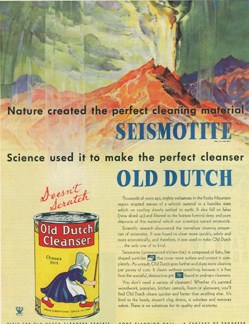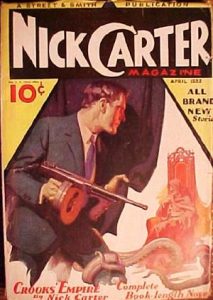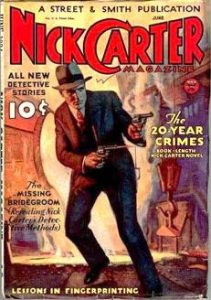 Our December 11, 2011 OTR offering featured a Nick Carter, Master Detective episode with a definite SF element. “The Mystery of the Z-Rays” has for some reason proved very popular with OTR enthusiasts, the hit counts more than double the usual weekly number. There are several variables which may account for this: the SF element, the interesting historical account of the history of Nick Carter in magazines, radio, film, and novels dating to over a hundred years, and its tie-ins with Street & Smith (original publishers of Astounding SF and The Shadow), or the fact that there are many Mystery as well as SF fans among us–or a combination of all of the above. For those who missed this episode and the history of Nick Carter, Master Detective, you can find it here.
Our December 11, 2011 OTR offering featured a Nick Carter, Master Detective episode with a definite SF element. “The Mystery of the Z-Rays” has for some reason proved very popular with OTR enthusiasts, the hit counts more than double the usual weekly number. There are several variables which may account for this: the SF element, the interesting historical account of the history of Nick Carter in magazines, radio, film, and novels dating to over a hundred years, and its tie-ins with Street & Smith (original publishers of Astounding SF and The Shadow), or the fact that there are many Mystery as well as SF fans among us–or a combination of all of the above. For those who missed this episode and the history of Nick Carter, Master Detective, you can find it here.
Mentioned in the introductory historical backstory of Nick Carter, Master Detective, was that Alfred Bester also wrote scripts for the popular show (as well as The Shadow and others), and that sometime in the future we would showcase one such. Herewith, we present the Bester episode titled “The Case of the Missing Street,” which aired on December 28, 1947. No SF trappings here, but a straight crime drama dealing with an innocent lad conned out of a property deal by scheming swindlers. What the old scam is, how it is discovered, and how Nick Carter outwits the crooks and sets things straight for the young lad (and his pretty young girlfriend), show that Bester was adept at writing for any market and across different media (radio, comic books, tv, and SF magazines), each with distinctly specific requirements. For instance, while radio was the “theatre of the mind” where sound effects added to the listener’s overall mental picture, and dialogue and other information had to be pared down to its most crucial elements in order to fit a 30-minute or less time frame to keep the story moving forward (not as easy as it may seem), writing for comic books was entirely different, where the medium was 100% visual–the opposite of radio. And again, while writing some of his best science fiction for the magazines during the 1940s, Bester knew how to draw on the visual aspect of the comic book medium (translating necessary visual description into prose), as well as fill in the mental pictures from his radio experience, in his stories. Pacing, timing, dialogue, scene structure; he learned how to incorporate these elements for each medium in which he worked.
It may seem obvious, but he also knew his markets. Writing for Nick Carter was different than writing for The Shadow (though both were at core detectives). Of Bester’s nine Shadow scripts six are considered “lost.” We presented the surviving three here on August 29, 2009, with the title “Three from the Shadow — Alfred Bester.”
Bester also wrote radio for Charlie Chan and Nero Wolfe, and as with The Shadow and Nick Carter, all were at heart detectives. Is it any wonder then, that with his first SF novel The Demolished Man, he blended the Mystery/Detective and SF genres, penning such a stunning masterpiece that it was awarded the first Hugo award for Best Novel and stands today as one of SF’s true classics?
Tming is everything, they say. It is fortunate then that we now have a classic interview with Alfred Bester posted here, hopefully to lend more insight into how and why he wrote what he did, and why it has stood the test of time. Listen now to Alfred Bester’s “The Case of the Missing Street” from Nick Carter, Master Detective.
 (PS: A lot of the fun listening to Old Time Radio is hearing the ads the sponsors provide for their products. The sponsor here is Old Dutch Cleanser–think Comet today. It hails as one of its prominent ingredients something called “seismotite” and sounds like something from out of this world. While googling Old Dutch Cleanser to find the correct spelling of seismotite I discovered it was also used as a douche back in the 1920s. It is still sold today, primarily in Dollar General stores and other such places scattered around the country. Way too much unexpected information, but interesting enough to pass along. The ad pictured here is from 1934. I’m not sure I’d use any product in a sensitive body area promoted by an erupting volcano.)
(PS: A lot of the fun listening to Old Time Radio is hearing the ads the sponsors provide for their products. The sponsor here is Old Dutch Cleanser–think Comet today. It hails as one of its prominent ingredients something called “seismotite” and sounds like something from out of this world. While googling Old Dutch Cleanser to find the correct spelling of seismotite I discovered it was also used as a douche back in the 1920s. It is still sold today, primarily in Dollar General stores and other such places scattered around the country. Way too much unexpected information, but interesting enough to pass along. The ad pictured here is from 1934. I’m not sure I’d use any product in a sensitive body area promoted by an erupting volcano.)
Play Time: 29:34
(Cover at top left from October 1934. Covers below from April 1933 and June 1934.)

